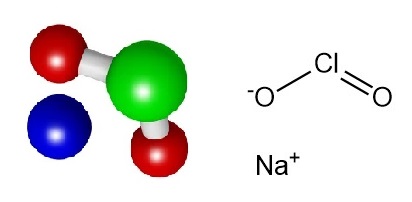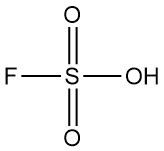
Table of Contents
1. Properties of Sodium Chlorite
Sodium chlorite is a solid salt with a molecular weight of 90.45 g/mol. It exists in both anhydrous and trihydrated forms (transition point: 38 °C). High-purity crystals are white but typically have a greenish tint due to the presence of chlorine dioxide (ClO2) as a trace impurity.
It possesses low impact sensitivity in the absence of organic matter. It can be struck with a clean metal surface without detonation. However, organic materials, such as the film on a hammer, can cause spontaneous puffing upon impact.
As a strong oxidant, solid sodium chlorite forms explosive mixtures with oxidizable materials like sulfur, powdered coal, metal powders, and organic compounds. Sodium chlorite solutions should never dry on fabrics to avoid creating flammable mixtures.
Sodium chlorite is soluble in water (Table 1), and its solubility is influenced by the presence of other substances like sodium hydroxide, sodium chlorate, sodium chloride, and sodium carbonate.
| Temperature, °C | Solubility, wt% |
|---|---|
| 5 | 34 |
| 17 | 39 |
| 20 | 40.5 |
| 30 | 46 |
| 40 | 50.7 |
| 45 | 53 |
| 50 | 53.7 |
| 60 | 55 |
Light exposure should be minimized for aqueous sodium chlorite solutions. At low pH (around 2), chlorite solutions contain chlorous acid, which decomposes to chlorine dioxide and chlorate:
4 HClO2 → 2 ClO2 + HClO3 + HCl + H2O
Decomposition slows down at pH 3–4. Alkaline solutions of sodium chlorite are stable, and dilute solutions can even be boiled without decomposition. Concentrated alkaline solutions decompose slowly upon heating:
3 NaClO2 → 2 NaClO3 + NaCl
The reaction of sodium chlorite with hypochlorite depends on pH. Chlorine dioxide is produced at low pH, while chlorate forms at high pH. A reaction with chlorine yields chlorine dioxide and sodium chloride:
2 NaClO2 + Cl2 → 2 ClO2 + 2 NaCl
Crystalline sodium chlorite exhibits slight hygroscopicity without caking. It requires alkaline stabilization for long-term storage. Heating to 180–200 °C causes partial decomposition to sodium chlorate and sodium chloride or complete decomposition to sodium chloride and oxygen.
Table 2 shows some physical properties of sodium chlorite.
| Property | Value |
|---|---|
| Chemical formula | NaClO2 |
| Molar mass | 90.442 g/mol (anhydrous) 144.487 g/mol (trihydrate) |
| Appearance | white solid |
| Odor | odorless |
| Density | 2.468 g/cm3 |
| Melting point | Anhydrous: decomposes at 180–200 °C Trihydrate: decomposes at 38 °C |
| Solubility in water | 75.8 g/100 mL (25 °C) 122 g/100 mL (60 °C) |
| Solubility | slightly soluble in methanol, ethanol |
| pKa | 10-11 |
| Enthalpy of formation | -307.0 kJ/mol |
2. Industrial Production of Sodium Chlorite
Sodium chlorite is produced by the reaction of chlorine dioxide with sodium hydroxide:
2 ClO2 + 2 NaOH → NaClO2 + NaClO3 + H2O
Sodium chlorite and sodium chlorate share similar water solubilities, making their separation challenging. The current industrial process relies on the absorption of chlorine dioxide in a sodium hydroxide solution with simultaneous chlorate reduction to chlorite using a suitable reducing agent, such as hydrogen peroxide:
2 ClO2 + 2 NaOH + H2O2 → 2 NaClO2 + 2 H2O + O2
This process yields a 33 wt% sodium chlorite solution. After processing steps, a dry solid containing approximately 80 wt% sodium chlorite and stabilizers is obtained.
While numerous complex chlorites have been synthesized, only sodium chlorite has significant commercial value.
Attempts to produce sodium chlorite by electrolysis, similar to the methods used for hypochlorite and chlorate, have been unsuccessful. Synthesis from chlorine dioxide and sodium amalgam proved unviable due to difficulties in controlling redox potential and pH. Other proposed methods for direct chlorine dioxide reduction lacked efficiency.
3. Uses of Sodium Chlorite
Sodium chlorite is used as a highly effective bleaching agent due to its specific oxidation potential. Unlike other bleaching agents, it allows for controlled bleaching processes, making it useful in the textile industry.
It can be used as a precursor for small-scale chlorine dioxide production.
Some of the common uses of sodium chlorite are:
- Disinfectant in a variety of applications, including drinking water treatment, food processing, and industrial settings.
- Bleaching agent in the pulp and paper industry and in textile bleaching.
- In some countries, sodium chlorite is used as a food additive to prevent the growth of bacteria.
- Low concentrations of sodium chlorite are used in some mouthwashes and toothpastes as an antimicrobial agent.
Reference
- Chlorine Oxides and Chlorine Oxygen Acids; Ullmann’s Encyclopedia of Industrial Chemistry. – https://onlinelibrary.wiley.com/doi/10.1002/14356007.a06_483.pub2




